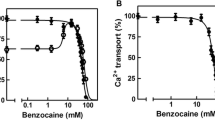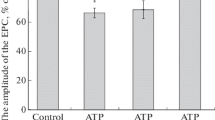Summary
Horseradish peroxidase, an extracellular marker, was given intravenously to frogs, and 40 min later the sartorius muscles were removed. The isolated muscles were exposed for an additional hour to Ringer solution containing peroxidase, then fixed with glutaraldehyde. Peroxidase activity was found in the T tubules, in some of the terminal cisternae (TC) of the SR, and occasionally in the longitudinal tubules of the SR. In transverse sections, the structures containing tracer formed a pattern of approximately parallel columns reaching to the cell surface; the statistical distribution of their spacing was nearly the same as that of the interdistances between the current-sensitive spots on the Z-line which triggered localized contraction (Huxley and Taylor, 1958). The caffeine contracture of frog sartorius muscles remained unchanged in isotonic Ringer solutions which were Ca++-free or contained Mn++ or La+++; however, contracture was blocked by prior exposure of the muscles to the same solutions made 2 × hypertonic with sucrose (known to produce swelling of T tubules and (TC). Since Mn++ and La+++ are known to depress Ca++ influx, these results suggest that washout of Ca++ from the TC, and penetration of La+++ or Mn++ into it, occur more rapidly due to the swelling of T tubules and TC associated with hypertonicity. It is concluded that at least some of the terminal cisternae are open to the interstitial fluid via the T tubules. Thus, depolarization of the T tubules could readly depolarize the cisternae and lead to Ca++ influx into the myoplasm.
Similar content being viewed by others
References
Adrian, R. H., Chandler, W. K., Hodgkin, A. L.: Voltage clamp experiments in striated muscle fibres. J. Physiol. (Lond.) 208, 607–644 (1970).
Bianchi, P. C.: Cell calcium, 1st edn. London: Butterworths and Co., Ltd. 1968.
Birks, R. I., Davey, D. F.: Osmotic responses demonstrating the extracellular character of the sarcoplasmatic reticulum. J. Physiol. (Lond.) 202, 171–188 (1969).
Blinks, J. R.: Influence of osmotic strength on cross-section and volume of isolated single muscle fibres. J. Physiol. (Lond.) 177, 42–57 (1965).
Bozler, E.: Distribution of non-electrolytes in muscle. Amer. J. Physiol. 200, 651–655 (1961).
Caputo, C.: Caffeine- and potassium-induced contractures of frog striated muscle fibers in hypertonic solutions. J. gen. Physiol. 50, 129–139 (1966).
Conway, E. J.: Nature and significance of concentration relations of potassium and sodium ions in skeletal muscle. Physiol. Rev. 37, 84–132 (1957).
Costantin, L. L., Franzini-Armstrong, C., Podolsky, R. J.: Localization of calcium-accumulating structures in striated muscle fibers. Science 147, 158–159 (1965).
Dydynska, M., Wilkie, D. R.: The osmotic properties of striated muscle fibers in hypertonic solutions. J. Physiol. (Lond.) 169, 312–329 (1963).
Ebashi, S., Lipmann, F. A.: Adenosine triphosphate-linked concentration of calcium ions in a particulate fraction of rabbit muscle. J. Cell Biol. 14, 389–400 (1962).
Eisenberg, B., Eisenberg, R. S.: Selective disruption of the sarcotubular system in frog sartorius muscle. A quantitative study with exogenous peroxidase as a marker. J. Cell Biol. 39, 451–467 (1968).
Eisenberg, R. S., Gage, P. W.: Frog skeletal muscle fibers: Changes in electrical properties after disruption of transverse tubular system. Science 158, 1700–1701 (1967).
Endo, M.: Entry of fluorescent dyes into the sarcotubular system of frog muscle. J. Physiol. (Lond.) 185, 224–238 (1966).
Falk, G., Fatt, P.: Linear electrical properties of striated muscle fibers observed with intracellular electrodes. Proc. roy. Soc. B 160, 69–123 (1964).
Fatt, P.: An analysis of the transverse electrical impedance of striated muscle. Proc. roy. Soc. B 159, 606–651 (1964).
Forssmann, W. G.: A method for “in vivo” diffusion tracer studies combining perfusion fixation with intravenous tracer injection. Histochemie 20, 277–286 (1969).
Franzini-Armstrong, C.: Studies of the triad. I. Structure of the junction in frog twich fibers. J. Cell Biol. 47, 488 (1970).
Gebert, G.: Caffeine contracture of frog skeletal muscle and of single muscle fibers. Amer. J. Physiol. 215, 296–298 (1968).
Harris, E. J.: Distribution and movement of muscle chloride. J. Physiol. (Lond.) 166, 87–109 (1963).
Hill, D. K.: The space accessible to albumin within the striated muscle fibers of the toad. J. Physiol. (Lond.) 175, 275–294 (1964).
Huxley, A. F., Taylor, R. E.: Local activation of striated muscle fibers. J. Physiol. (Lond.) 144, 426–441 (1958).
Huxley, H. E.: Evidence for continuity between the central elements of the triads and extracellular space in frog sartorius muscle. Nature (Lond.) 202, 1067–1071 (1964).
—, Page, S., Wilkie, D. R.: An electron microscopic study of muscle in hypertonic solutions. Appendix to Dydynska, M., and Wilkie, D. R., J. Physiol. (Lond.) 169, 312–329 (1963).
Kelly, D. E.: The fine structure of skeletal muscle triad junctions. J. Ultrastruct. Res. 29, 37–49 (1969).
Luft, J. H.: Ruthenium red staining of the striated muscle cell membrane and the myotendinal junction. Sixth International Congress for electron microscopy, Electron Microscopy, vol. II, edit. by R. Uyeda. Nihonbashi, Tokyo: Maruzen Co. 1966.
Natori, R.: Propagated contractions in isolated sarcolemma-free bundle of myofibrils. Jikeikai med. J. 12, 214–221 (1965).
Peachey, L. D.: The sarcoplasmic reticulum and transverse tubules of the frog sartorius. J. Cell Biol. 25, 209–231 (1965).
—, Schild, R. F.: The distribution of the T-system along sarcomeres of frog and toad sartorius muscles. J. Physiol. (Lond.) 194, 249–258 (1968).
Porter, K. R., Palade, G. E.: Studies on the endoplasmic reticulum. III. Its form and distribution in striated muscle cells. J. biophys. biochem. Cytol. 3, 269–300 (1957).
Rogus, E., Zierler, K. L.: Test of a two-component model for sodium flux: osmotic behavior of sarcoplasm and sarcoplasmic reticulum. Fed. Proc. 29, 455 (1970).
Shaw, F. H., Simon, S. E., Johnstone, B. M., Holman, M. E.: The effects of changes of environment on the electrical and ionic pattern of muscle. J. gen. Physiol. 40, 263–288 (1957).
Simon, S. E., Shaw, F. H., Bennet, S., Muller, M.: The relationship between sodium, potassium and chloride in amphibian muscle. J. gen. Physiol. 40, 753–777 (1957).
Sperelakis, N., Schneider, M.: Membrane ion conductances of frog sartorius fibers as a function of tonicity. Amer. J. Physiol. 215, 723–729 (1968).
Tasker, P., Simon, S. E., Johnstone, B. M., Shankly, K. H., Shaw, F. H.: The dimensions of the extracellular space in sartorius muscle. J. gen. Physiol. 43, 39–53 (1959).
Walker, S. M., Schrodt, G. R.: Triads in skeletal muscle fibers of 19-day fetal rats. J. Cell Biol. 37, 564–569 (1968).
Weiss, G. B.: On the site of action of lanthanum in frog sartorius muscle. J. Pharmacol. exp. Ther. 175, 517–526 (1970).
Winegrad, S.: Intracellular calcium movements of frog skeletal muscle during recovery from tetanus. J. gen. Physiol. 51, 65–83 (1968).
Author information
Authors and Affiliations
Additional information
Supported by grants from the Public Health Service (HE-11155, HE-05815, and HE-10384) and from the American Heart Assocation. The authors are indebted to Mrs. Jan Redick for expert technical assistance.
Rights and permissions
About this article
Cite this article
Rubio, R., Sperelakis, N. Penetration of horseradish peroxidase into the terminal cisternae of frog skeletal muscle fibers and blockade of caffeine contracture by Ca++ depletion. Z. Zellforsch. 124, 57–71 (1972). https://doi.org/10.1007/BF00335454
Received:
Issue Date:
DOI: https://doi.org/10.1007/BF00335454




